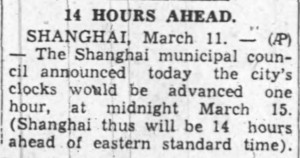How Time Changes in China – And Why There are no Time Zones
Posted: May 4th, 2015 | 1 Comment »Anyone who’s ever been to the extreme north-east of China, Turkestan or stood in the dark requiring flood lights to watch the horses at Happy Valley at half past six of an evening will perhaps have asked themselves if China always had a one-nation-one-time zone policy. Of course it makes no sense whatsoever and is just a silly Maoist policy to show some sort of unified China.
It was not always so in saner times. One of the first acts of the new Republican government in 1912Â was to divide China into five time zones ranging from GMT+5.5 to GMT+8.5 – Kunlun time, Sinkiang-Tibet time, Kansu-Szechuan time, Chungyuan Standard time and Changpai time. These time zones held till 1949 when Mao said there was only one leader and only one time.
Plus there was sensibly also summer time, allowing for more daylight (very nice for farmers) – but only in the treaty ports of Tientsin and Shanghai. Other parts of China, seeing the sense in it, adopted it as various stages and parts of China kept it till the early 1960s.
So now you know…

I was teaching in China in the mid-80’s when China tried again to introduce daylight savings time. It was the funniest thing. My students staggered around in a jet-lag-like daze for weeks, complaining how they were so tired because they had lost an hour. And the government modified all the plane and train schedules to, as far as I could tell, keep them lined up with the sun. Then back again in the fall. I was still in China ten years later when the abandoned the whole thing, saying that it was “too complicated.” One of the funniest experiences of my 20+ years in China!